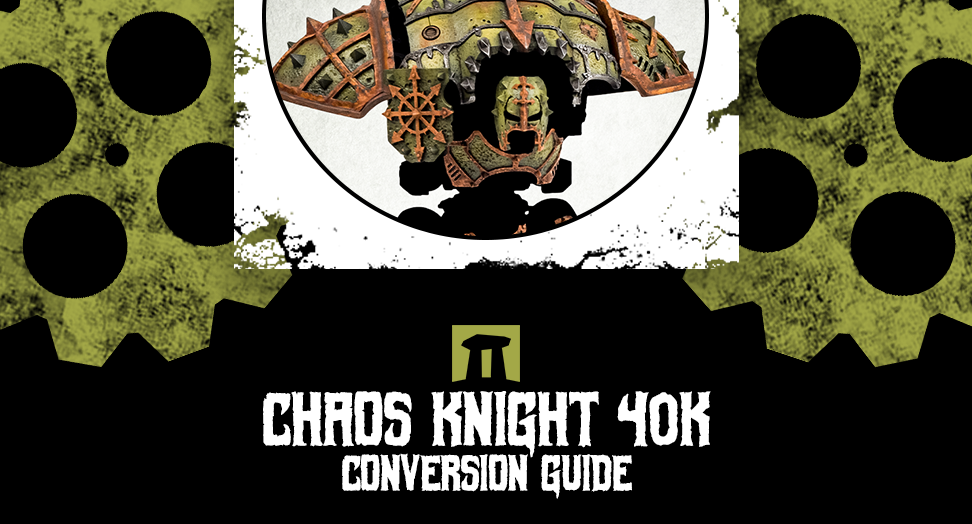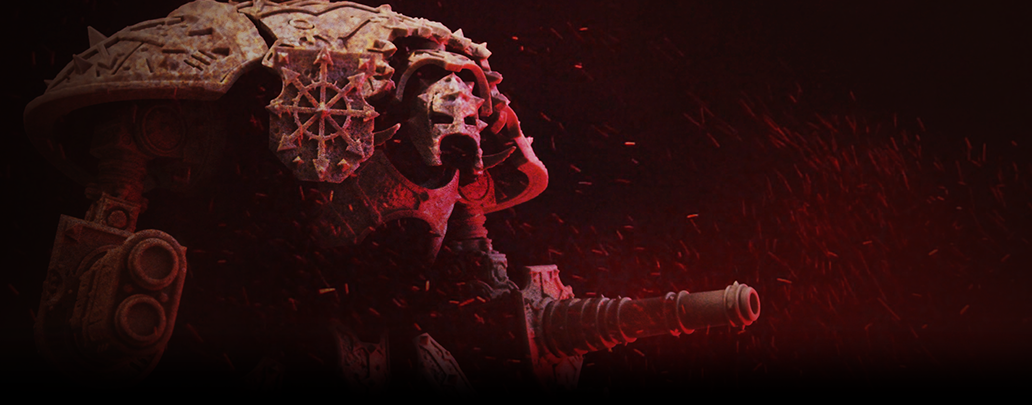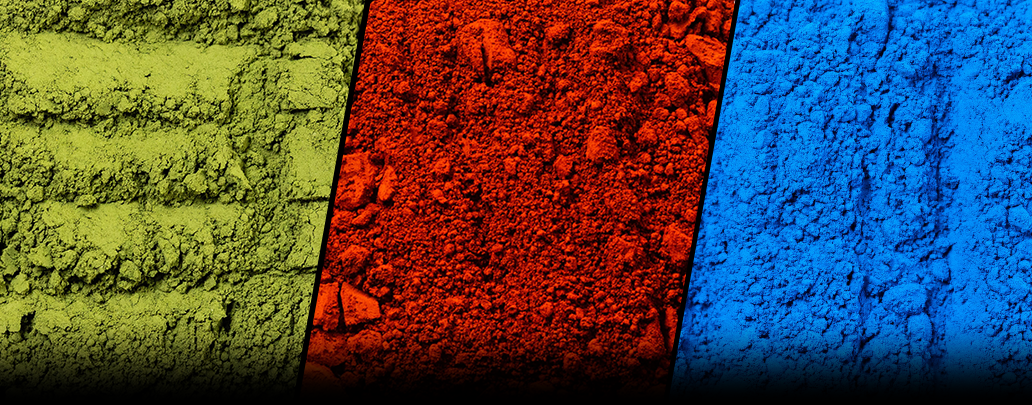Chaos Knight 40k - conversion guide

Undoubtedly, Chaos Knights are among the most impressive Warhammer 40k models in the regular sale offer of Games Workshop. Just like their Imperial siblings, these are imposing figures - both from the visual and gameplay point of view.
What is Chaos Knight 40k and what are its key features
If you ever looked for some Warhammer 40k art, you surely noticed huge, titanic machines towering above battlefields, bringing death and destruction on a massive scale. Although there are many unbelievably gigantic human-shaped vehicles in this grim dark future universe, Knights - both Chaos and Imperial - are the most commonly encountered and, in effect, the most recognizable.
Chaos Knight is (just like many other units among servants of the Dark Gods) a corrupted, twisted version of construction made by mankind - a noble, breathtaking Imperial Knight. Due to the influence of the highly unpredictable forces of Chaos Gods, this once majestic machine became even more dangerous.
Suppose you still can’t imagine how such an enormous humanoid vehicle would look in real life. Consider watching the “Pacific Rim” motion picture. In that case, it should be an appropriate source of fuel for your imagination. And (assuming that the conception of colossal robotic constructions fighting one another fully sank into your mind) now it’s time for a closer in-game look at the Chaos Knight.
The key features of this Jaeger-type of warmachine on the wargaming table are precisely what you can imagine (and as it looks from the perspective of a fictional 40k reality in which Knights exist). This unit is big and possesses massive durability and firepower - not to mention its ability to crush enemies with its powerful metal limbs in close combat!

Fallen Knight - truly imposing piece of war machinery
The one crucial thing to remember is that from the rules point of view, all of these features come for a proportional price. That price is in the points - Chaos Knight costs its value in them, which can significantly impact the shape of your entire force. Hulking machine means less number of other units.
Another thing you shouldn’t forget is that Chaos Knight - besides the relatively straightforward, logical advantages it brings to the table - also possesses some disadvantages. Most of these disadvantages are connected to the point value we stated earlier. They might be a fair reflection of Knight’s possibilities, but - after all - you get only one model for so much. That scenario requires some specific, careful army building, just for balance’s sake.
Nonetheless, although the usefulness of Chaos Knight on the wargaming table will always be questionable - it’s a matter of debates and advantages of opposing armies - there is one thing about this model that can’t be denied. There’s no doubt (at least in our minds) that Chaos Knight is an excellent addition to any battle from the visual point of view. It helps the whole army look better and more imposing. It’s also a joy to watch as this gigantic, well-sculpted model stomps through the battlefield - whether for victory or defeat.
How to get started with Chaos Knight 40k
To get started with Chaos Knight, you need to have one in the first place. Sounds easy, and it rather is, but - like with many things - you have more than one way to achieve that.
What you need to pay attention to is that there is more than one type of these machines. In that case, we aren’t discussing the difference between these behemoths assigned to different factions. That difference is pretty straightforward and easy to notice. Even at Kromlech, we have a wide range of gaming accessories inspired by both noble versions of Knights and corrupted ones - including battle rulers, which are especially handful when it comes to operating in the tight space of such enormous, valuable models. And speaking about practical stuff to use during your games, also take a look at our battle dice, tokens, markers, templates, etc. - among them, you’ll find even more accessories that will help you handle your Knight.
Returning to the subject: the differences occur even between the Knights from the same faction. There are several types of both Imperial and Chaos versions of these machines. Noticing that all of them possess optional weaponry, we can conclude that ahead of you lies many possibilities. It looks like before you decide to afford a 40k Knight, you should make sure you know which one you want.
The benefits of conversion guides for Chaos Knight 40k players
And what if you don’t need to ensure which Knight you want? What if there is a way of making your Knight’s preparation process much more manageable? To be entirely fair, that way which we would like to tell you about exists, and it can be easier for some. But, unfortunately, on the contrary, it might be more complicated for others. The way we have in mind is - something that is rather often our subject - to make a conversion, of course!

Weapon selection for Fallen Knight is almost as enormous as the Knight itself
With a model so enormous in size as Chaos Knight, the converting process itself might be straightforward and more fun. When you have large elements, it’s always easier to attach them to one another. What’s more, when doing such a conversion, you’re gifted with much more surface to cover with your own ideas - you have plenty of space to add desired bits and extras.
There is one actual difference (and difficulty) when comparing the conversion process of a Chaos Knight to some basic human-sized model. When you require fitting bits to replace the parts of such a huge model, you have fewer options when searching for substitutes. Nonetheless, you aren’t entirely abandoned. You can always go to our webstore, where you can find conversion parts dedicated specifically to enormous models in the type of the Knight. Please browse our catalog and discover bits dedicated to both noble versions of such machines and depraved ones.
A step-by-step guide on converting your models for use in the game
To convert your Chaos Knight model, you’ll need the main body of this machine. After all, without an appropriate core - a skeleton or even a spine, if you prefer to call that this way - you won’t be able to begin the conversion process. The body, which consists of the glued elements communal to all of the basic Knights (these that are different only when it comes to the weaponry - not when it comes to the type of the entire machine), will be your base.
If you already have your base, you can begin to add some components. Taking our Fallen Knight Armour Kit as an example, you can make your Knight have unique armor on the back, legs, and chest. What’s more, you can also swap his mask and shoulder pads. Finally - just like a cherry on the top - there is a range of possible extra components that you can add to your model. These include banners and shields, not to mention even more spikes and similar bits in a clime that you’ll find at our webstore - both among the resin and 3D ones in the Kromlech 3D Workshop category.
But the fun doesn’t end there! Once you have your Chaos Knight almost completely assembled, you’ll be able to attach one more crucial thing - the weaponry. To do so, you can return to our line of products dedicated to Knightly models. Among different sets, you’ll find many examples of devastating weapons suitable for a mech as giant as 40k Knight. You can choose between Minigun Arms, Heavy Magma Cannon Arms, Battle Cannon Arms, Laser Cannon Arms, Unholy Blade Arms, and both left and right Infernal Fist Arms. What’s more, there are also pieces of wargear that you may find suitable for the back of your Chaos Knight. These are Carapace Rocket Launcher and Carapace Twin Autocannon.
As you can see, the cafeteria of possible changes is just like the machine we’re writing about - enormous. Once you convert your model, you’ll undoubtedly find more than what we stated here. And if you’re the one who didn’t surrender his soul to the Dark Gods of Chaos, you can always take a look at our Questing Knights bits. They may not be as numerous as those dedicated to the Chaos-like machines, but you can find there a suitable set of armor plates.
And slowly closing the converting possibilities subject, we can’t forget about the base (not the skeleton of the Knight, but the base on which it stands). Of course, a model so gigantic as this one has a proportional base. That fact gives us a wide range of possible add-ons like pieces of terrain, bits, etc.

Weathering Powders might grant you amazing effects if used correctly on such a huge model
If you’re short on ideas, browse the modeling and basing category at our webstore. There you’ll find tools to make the conversion process much more straightforward and modeling accessories such as Static Grass, Basing Sand, Cork Scatter, Plasticard Sheets, magnets, hobby chains, and more. And what might be the most practical from that entire catalog, when thinking about the Chaos Knight conversion, are our HDF Glyphs and Weathering Powders.
Examples of converted models and how they look in the game
When you do a conversion, the effect of your work should be tricky. That’s because the done transformation should be visibly unique (or just different) for someone who knows about this hobby. After all, that’s the main point of converting a model - distinguishing it from all the rest. Nonetheless, on the other hand, the finished conversion should seem like a typical model (not varying from others in the sense of design and clime) for the people who don’t necessarily know what wargaming is all about.
To sum up - converted models should look different when it comes to the idea itself, but at the same time, they should be done in the spirit of a wargame you’re playing in.
What’s always practical when displaying your conversion is the terrain. Portraying any model on a suitable background can level immersion to unmeasurable heights and help to recognize what it is, even the not-so-die-hard fans.
For the terrain matching all types of Knights, look in the Tabletop Scenics section at our webstore. The likes of Cargo Containers and Habitats (Ruined, Collapsed, and the whole ones) should look perfect next to your mighty machine.
Tips for painting your converted models to match the rest of your army
Painting such a massive model like Warhammer 40k Knight is another thing in this article that possesses two faces. When the figure is that gigantic, everything about painting it should be easier than with other, much smaller models. While it’s a true statement to a certain point, we can’t skip another crucial fact. When the miniature is enormous, it probably also possesses a tremendous amount of detail. These details are very likely to be well visible, which (in some way) forces you to paint them precisely, and (in effect) be as much precise during the whole painting process.
When painting Chaos Knight, it’s especially significant to plan your work in the name of this practical advice: to start painting with more noticeable elements, ending with the smallest ones. And if you want your giant machine to match the rest of your army, try to stick to the same pattern you used while painting other models. Or, at least, use the same color scheme. Slight differences shouldn’t be noticed as long as all of your work will be done with heart and precision - two features that we’re sure you aren’t short on.




